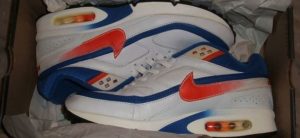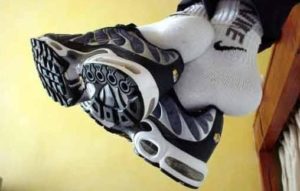
Nike Air is a shoe with one of the longest and most interesting histories. It is both a classic and a modern shoe that keeps developing with time, which is what enables it to stay alive and relevant.
Nike Air was developed by an aerospace engineer named Marion Franklin Rudy. He gave up his job in the aerospace industry because his life goal was to create practical solutions for ordinary people.

He came up with the idea of adding air pockets to shoe soles in order to minimize the impact while walking and running. His solution was rejected by 23 shoe companies. Finally, in 1977, he presented his air sole to the Nike co-founder, Phil Knight, who loved the idea after a test run.
The rest, as they say, is history.
The 70s: The Early Beginnings
Right after Phil Knight accepted the idea shown to him by Marion Franklin Rudy, Nike began developing their first shoe which would have air soles. Their customers did not have to wait long, as the first shoe with air cushioning, named Nike Tailwind, was released in 1978.

At first, people were apprehensive about the new technology and had some doubts. That all ended in the 1980s when researchers at the University of Tennessee concluded that runners used less energy and suffered lower impact forces when they ran in Nike Tailwind shoes.
The 80s: The Breakthrough of Nike Air
The 80s were the years when the world received the Nike Air Max 1 shoe. It was designed by the shoe industry legend, Tinker Hatfield, who took a risk that turned out to be worth taking.
Nike recognized the people’s need for something different and experimental when it comes to streetwear. Thus, they decided to create an experiment and give the world something that was not seen before.

Nike Tailwind had air soles which were hidden inside regular soles, so one could never know that they were there. However, Nike Air Max 1 is the first shoe that made air soles visible. Soon after, that became the standard.
The 90s: The Nike Air Boom
In the 1990s, Nike Air reinforced its position as the shoe of the century. Nike’s engineers started working harder on developing the Air shoes further and created numerous different versions. Some iterations include forefoot Air, Tuned Air, and full-length Air.

Numerous models were released during this decade, including Air Max 90, Air Max Plus, Air Max 95, Air Max 97, and many others. This epoche saw some other cultural developments as well, such as Hip Hop and the growth of general interest in streetwear, which Nike Air managed to profit from.
Nike Air Today: A Living Legend
Nike Air, even though more than 40 years old, is still very much alive today. Nike engineers keep experimenting with the shoe, offering their fans something new each year. Today, Nike Air shoes are a symbol of progress and boldness, often introducing never before seen colors, patterns, shapes, and materials.

One of the best examples of Nike’s experimental approach is the Nike Air 720, which is diametrically different from anything seen before. Some Nike fans love it, and others think it’s a bodge. But, one thing is certain — it is bold and revolutionary.
Conclusion
A lot can be said about the history of Nike Air shoes. Its path to fame was filled with success and failure, but it will forever remain a symbol of progress and youthfulness. Like the Converse Chuck Taylor, it is a shoe that will never die.
